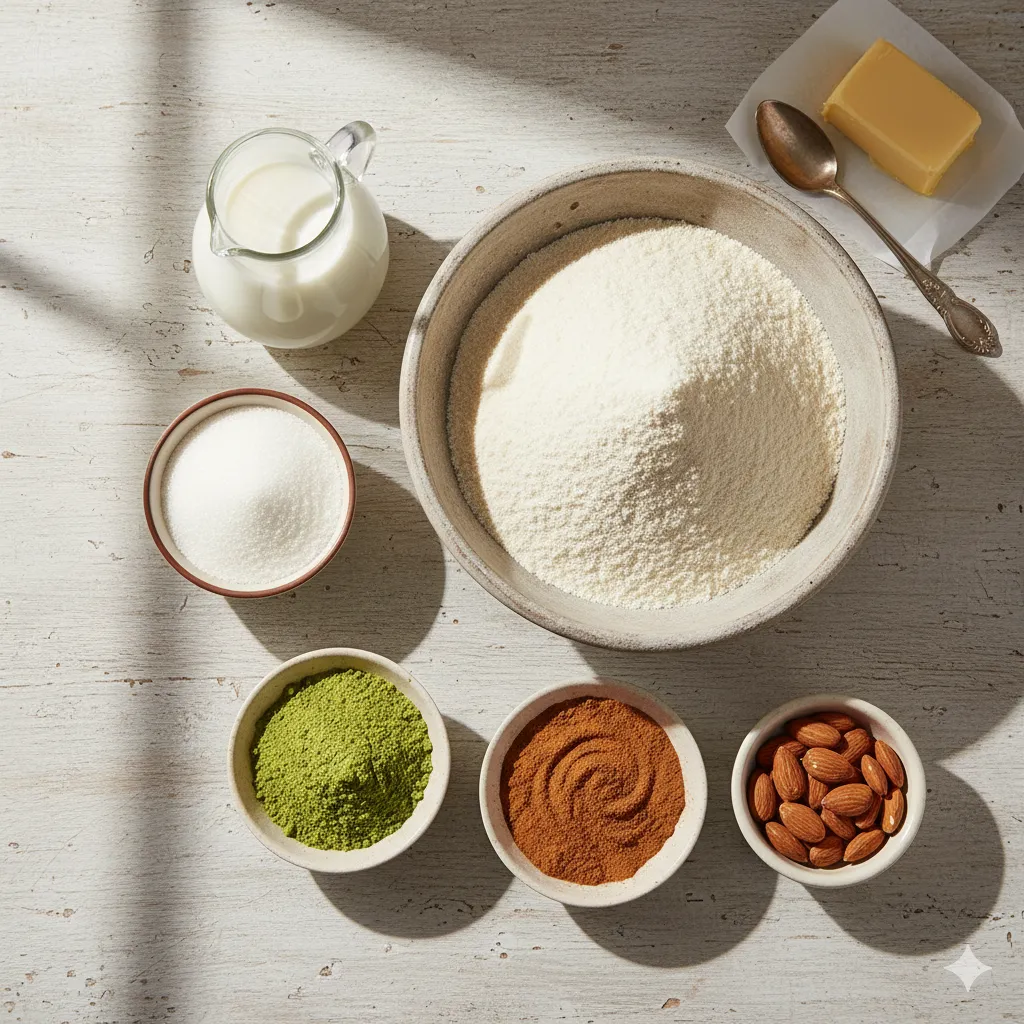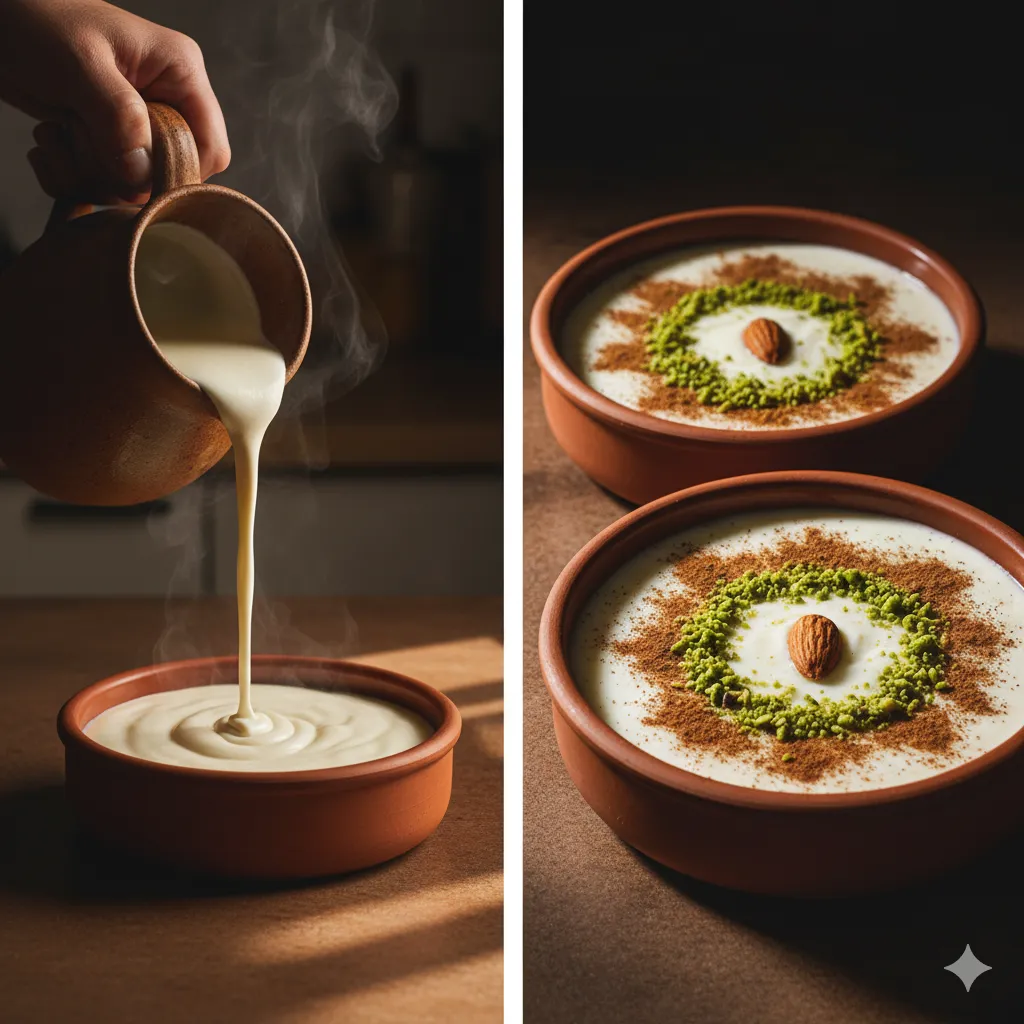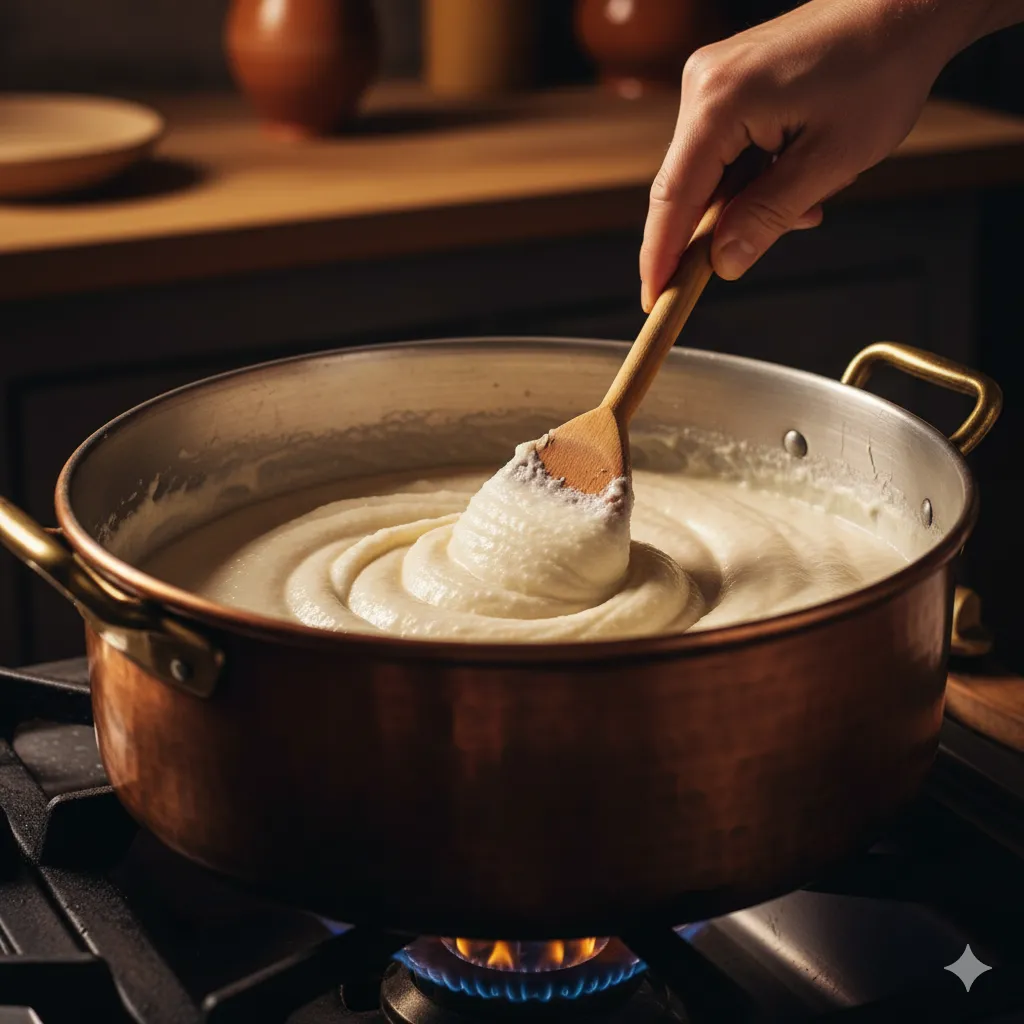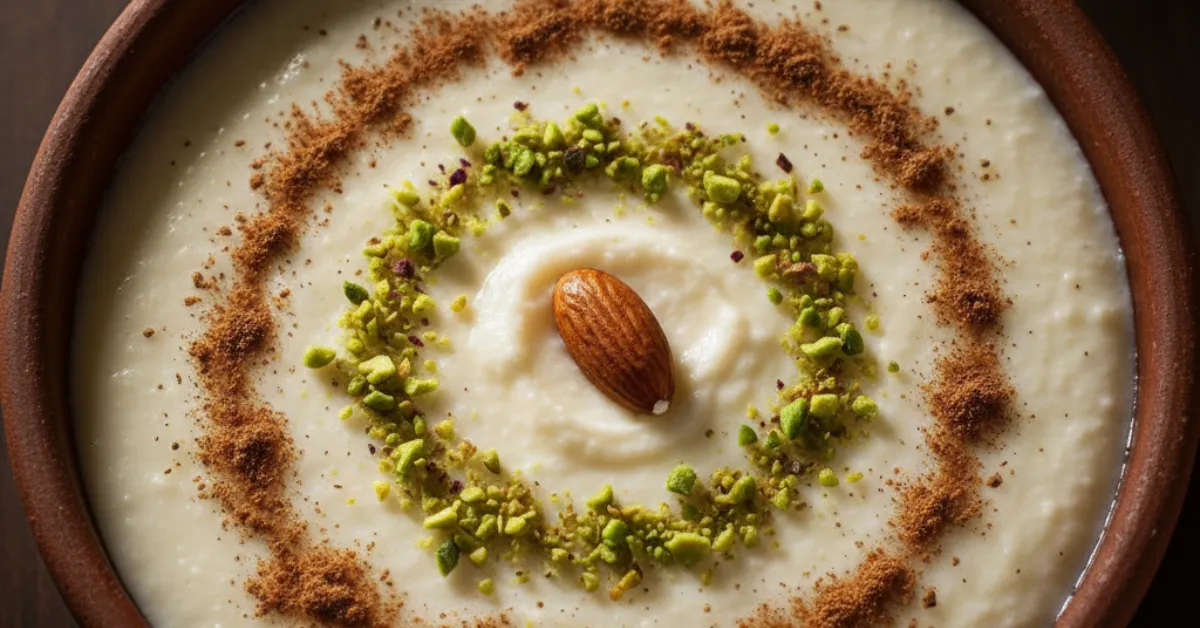The **Assida Bidha** (White Porridge) is a deceptively simple dessert that holds immense cultural significance, particularly in Tunisia. Unlike its famous brown cousin (*Assida Zgougou*), this white semolina cream is often prepared for everyday treats, special family occasions, or as a classic comfort food. It’s rich, creamy, and perfectly spiced—a truly **amazing** recipe that provides a delicious taste of North African heritage.

The beauty of this **Assida Bidha recette** lies in its purity: it uses only basic pantry ingredients like fine semolina, milk, sugar, and water. Mastering the preparation requires patience during the slow cooking phase to ensure the semolina is fully cooked, yielding a smooth, velvety consistency instead of a lumpy paste. This simple dessert is an excellent choice for your **Quick Recipes** collection, as the active cooking time is surprisingly short.
- Essential Ingredients for Assida Bidha Tunisienne
- The Water-Bath Method for Smooth Assida Bidha
- Mixing and Heating the Semolina Cream:
- The Final Flavor and Serving:
- Tips for Perfect Texture and Flavor
- Storage, Meal Prep, and Variations
- FAQ: Your Questions About Assida Bidha
- Conclusion: The Ultimate Traditional Dessert
- Recipe Summary: Quick Assida Bidha
- Steps to Follow (How to Cook Assida Bidha)
- Tools You’ll Need
Mastering the Assida Bidha Recette: Secrets to a Smooth Cream
The texture is everything when making **Assida Bidha**. It should be thick enough to hold its shape in a bowl but smooth enough to be eaten with a spoon. Lumps are the enemy of a perfect *asida*.
Essential Ingredients for Assida Bidha Tunisienne

The traditional **Assida Bidha tunisienne** uses just a few simple items, but the quality of the semolina and milk greatly influences the final flavor and richness:
- **Semolina:** Use *extra fine* or *fine* semolina flour (semoule fine). Coarse semolina will result in a grainy texture.
- **Dairy:** Whole milk and unsalted butter contribute necessary richness and creaminess.
- **Flavor:** Rose water or orange blossom water adds a traditional North African floral aroma that is the hallmark of the dessert.
- **Sweetener:** Granulated sugar, adjusted to taste.
The Water-Bath Method for Smooth Assida Bidha
The most common mistake when preparing **Assida Bidha** is adding the semolina directly to the hot milk, which immediately results in stubborn, unpleasant lumps. We use a cold-start method combined with a water bath (or double boiler) technique to ensure a perfect, velvety smooth texture:
- **Cold Mix:** Whisk the fine semolina and a portion of the cold milk and water *before* heating. This ensures the starch particles are fully separated and hydrated before they gelatinize.
- **Low Heat:** Once the mixture is smooth, transfer it to a large, heavy-bottomed pot and cook over low-to-medium heat. The process requires constant, gentle stirring to prevent sticking.
This gentle, prolonged heating process allows the semolina to cook completely and release its starch evenly, leading to a smooth, thick, and perfectly textured cream.
Step-by-Step Instructions: How to Cook Assida Bidha

Follow these steps precisely. Patience during the stirring phase is the secret to a flawless **Assida Bidha**.
Mixing and Heating the Semolina Cream:
- **Prep the Base:** In a large, heavy saucepan (or *casse-role*), whisk the fine semolina with the cold water, milk, and sugar until absolutely smooth.
- **Thicken:** Place the pot over medium-low heat. Cook the mixture, stirring **continuously** with a wooden spoon or whisk. As the cream heats, it will begin to thicken significantly (this will take 10–15 minutes). The heat must be low to prevent burning and sticking.
- **Cook Through:** Continue stirring until the mixture pulls away cleanly from the side of the pot. This is essential to fully cook the semolina starch.
The Final Flavor and Serving:

- **Add Finishers:** Remove the pot from the heat. Stir in the butter and the traditional splash of rose water or orange blossom water. The butter should melt quickly into the warm cream.
- **Portion:** Immediately pour the warm **Assida Bidha** into small serving bowls, cups, or ramekins. The cream will set quickly as it cools, so work fast.
- **Chill and Garnish:** Allow the bowls to cool slightly at room temperature, then cover and chill in the refrigerator for at least 2 hours. Serve cold, garnished traditionally with cinnamon, crushed nuts (almonds or pistachios), or dried fruit.
Deep Dive: Cultural Context and Flavor Layering in Assida Bidha

The **Assida Bidha** is more than just a dessert; it is deeply embedded in the religious and social fabric of Tunisian and North African culture. It is a staple during religious festivals like *Mawlid an-Nabi* (the Prophet’s birthday) and is often served to new mothers to provide quick, gentle energy. Its simplicity and pure white color symbolize purity and renewal, making it suitable for many celebratory occasions. This is why the **Assida Bidha recette** is passed down with such reverence, emphasizing technique over complex ingredients.
The pairing of this dish with highly aromatic floral waters, such as **rose water** or **orange blossom water**, provides a distinct flavor profile that is foundational to regional desserts. The floral note contrasts beautifully with the warm, earthy notes of the cinnamon garnish and the rich, creamy semolina base, creating a balanced sensory experience. This attention to layered aromas is a hallmark of successful North African and Mediterranean sweets. Furthermore, for those interested in contrasting global comfort foods, the techniques of controlled cooking required for this pudding are similar to those needed for our **[Crab Brulee Recipe]** (another custard requiring gentle heat) and the high-fat texture of the **[Lemon Cake Cookies]** (https://flavorillarecipes.com/lemon-cake-cookies), which also requires careful temperature management. Mastering this simple **Assida Bidha recette** unlocks a delicious piece of world cuisine.
Tips for Perfect Texture and Flavor
Even though the **Assida Bidha** uses few ingredients, technique is vital for achieving the correct texture.
- **Avoid Lumps:** Always mix the semolina with cold liquid *before* heating. If lumps form during cooking, quickly remove the pot from the heat and whisk vigorously until smooth before returning it to low heat.
- **Thickening Test:** The cream is ready when it starts to bubble and is thick enough to coat the back of a spoon without running. It should pull cleanly away from the side of the pot when stirred.
- **Serving Temperature:** While traditionally served chilled, **Assida Bidha** can also be served warm immediately after cooking, making it a delicious **Dinner** or **Lunch** treat.
Storage, Meal Prep, and Variations
The **Assida Bidha tunisienne** is an ideal make-ahead dessert.
Storage and Meal Prep:
- **Chilling:** Once poured into serving bowls, the cream will keep well in the refrigerator for up to 4 days. Ensure the bowls are covered with plastic wrap pressed directly onto the surface to prevent a skin from forming.
- **Freezing:** Freezing is not recommended, as the starch structure and dairy may separate upon thawing, resulting in a grainy texture.
Variations (Assida Bidha Recette):
- **Dairy-Free:** Substitute the milk and butter with full-fat canned coconut milk and a high-quality vegan butter for a rich, flavorful dairy-free version.
- **Spiced:** For a deeper autumnal flavor, add a pinch of turmeric and ground ginger along with the cinnamon, providing extra warmth.
For more authentic North African cooking techniques, consult authoritative resources such as **Morocco World News’ Guide to Tunisian Assida**.
FAQ: Your Questions About Assida Bidha
What is Assida Bidha?
**Assida Bidha** is a traditional Tunisian and North African dessert cream or pudding. It is made from fine semolina flour cooked slowly with milk and sugar until thick and velvety, usually flavored with butter and floral waters, and served chilled with cinnamon and nuts.
What is Assida Bidha Recette made of?
The basic **Assida Bidha recette** uses only four primary ingredients: fine semolina, milk, sugar, and water, often finished with butter and aromatic additions like rose water or orange blossom water. It is a simple, highly nourishing dessert.
How is Assida Bidha tunisienne traditionally served?
**Assida Bidha tunisienne** is traditionally served cold in small individual bowls. It is customary to garnish the top with ground cinnamon (often creating patterns), crushed nuts (pistachios or almonds), and sometimes a layer of light cream or syrup.
Why does my semolina cream have lumps?
Lumps form in the **Assida Bidha** when the semolina flour is added directly to hot liquid or when the cream is not stirred continuously while heating. To prevent this, always mix the semolina with cold milk first, then cook slowly over low heat, stirring constantly until thick.
Can I use coarse semolina for this Assida Bidha recipe?
Using coarse semolina is not recommended for this **Assida Bidha recipe**, as it will result in a grainy, thick texture that is not ideal for a smooth cream. For the true velvety consistency, you must use extra fine or fine semolina flour.
Conclusion: The Ultimate Traditional Dessert
The **Assida Bidha** is an amazing recipe that brings simple, comforting North African flavor to your table. By utilizing the slow-cook, cold-start method, you guarantee a perfect, velvety smooth cream every time.
Embrace this cultural staple as a satisfying, elegant addition to your **Dinner** or **Quick Recipes** menu. It is truly a rewarding dish to share.
Recipe Summary: Quick Assida Bidha
→ Ingredients
- 1 cup Fine Semolina Flour
- 4 cups Whole Milk
- 1 cup Water
- 1/2 cup Granulated Sugar (or to taste)
- 2 Tbsp Unsalted Butter
- 1 Tbsp Rose Water or Orange Blossom Water (optional)
- Cinnamon and Crushed Nuts (for garnish)
Steps to Follow (How to Cook Assida Bidha)
- **Cold Mix:** Whisk semolina, water, milk, and sugar in a heavy pot until completely smooth.
- **Thicken:** Cook over medium-low heat, stirring constantly, for 10–15 minutes until the mixture thickens and pulls away from the side of the pot.
- **Finish:** Remove from heat. Stir in butter and rose water until smooth.
- **Chill:** Pour immediately into small serving bowls. Cool slightly, then chill for at least 2 hours. Garnish before serving.
Tools You’ll Need
- Heavy-bottomed saucepan
- Whisk and wooden spoon
- Small serving bowls/ramekins

